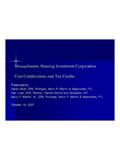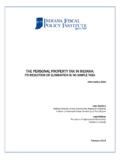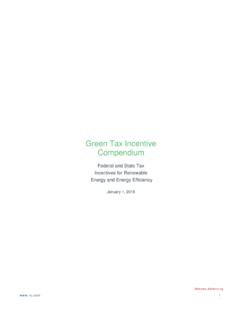Transcription of Advanced Topics in Low Income Housing Tax Credits
1 Advanced Topics in Low Income Housing Tax Credits (Clifton Hall) Biographical Information Tim Flaherty, CPA is the managing partner of Salmin, Celona, Wehrle & Flaherty, LLP, CPAs and also heads up the affordable Housing practice of the firm. Tim s clients include approximately 200 real estate entities most of which are low- Income Housing tax credit properties. His involvement with these entities includes consulting in the various aspects of affordable Housing development and management as well as traditional compliance related services. Tim is a member of NYSAFAH, CARH, NYSRRHA, AHACPA, the AICPA and the Nevada State Society of CPAs. Prior to joining the firm, Tim was an audit manager at Coopers & Lybrand (now PricewaterhouseCoopers) in Rochester. Tim is a 1982 graduate of St.
2 Bonaventure University. Tim was also an adjunct professor at St. John Fisher College in Rochester from 1986 to 1992. Jim DeBellis is a partner of Salmin, Celona, Wehrle & Flaherty, LLP, CPAs in Rochester. Jim heads up the Tax Department of the firm. Jim has 15 years of experience in the affordable Housing sector in the area of Low Income Housing Tax Credit compliance and planning. He also concentrates heavily in the area of Partnership taxation as well as traditional planning and compliance related services in the areas of small business, individual and estate taxation. Jim is a member of, the AICPA. Prior to joining the firm, Jim was a Tax manager at two other local accounting firms in Rochester Jim is a 1982 graduate of Niagara University. Tim Favaro concentrates his practice in the areas of community development , affordable senior and multi-family Housing development , and commercial property development utilizing various tax driven development incentives including, among others, the Low- Income Housing Tax Credit, the New Market Tax Credit, the Federal and New York Historic Tax Credit and the New York State Empire Zone program.
3 Mr. Favaro is from Ithaca, New York and he is a graduate of the State University of New York at Buffalo School of Law. Mr. Favaro joined the law firm of Cannon Heyman & Weiss, LLP in May of 2004. Raymond P. Reichert is a partner in the Firm's Tax and Economic & Land development practice groups. He has devoted substantially his entire career to the practice of tax law with a primary focus on partnership and LLC taxation, including syndication of Housing tax Credits and historic tax Credits . He also represents publicly traded Real Estate Investment Trusts in equity financing and investment transactions utilizing LLC's.. In addition, his practice includes structuring real estate joint ventures, low Income Housing and economic development planning. From 1990 to 1992, he held the position of Adjunct Assistant Professor of Law at the State University of New York at Buffalo School, where he taught the basic federal Income tax course, and for several years taught the partnership tax course.
4 He has lectured on numerous occasions with regard to tax and economic development related subjects. Mr. Reichert holds a from Fordham University and a State University of New York at Buffalo. 2 Upstate New York Affordable Housing Conference 2008 Speakers & Topics for Advanced LIHC Breakout Session September 23, 2008 Moderator: Timothy R. Flaherty, CPA Partner Salmin, Celona, Wehrle & Flaherty, LLP CPAs in Rochester, NY Speakers: Tim M. Favaro, Esq Cannon Heyman & Weiss, LLP in Buffalo, NY James S. DeBellis, CPA Partner Salmin, Celona, Wehrle & Flaherty, LLP CPAs in Rochester, NY Raymond P. Reichert Partner Jaeckle Fleischmann & Mugel, LLP in Buffalo, NY Session breakouts: 1) Not-for-profit (NFP) involvement & NFP controlled GP entities (Tim Favaro) I. Background II. Application for Recognition of Exemption IRS April, 2006 and July, 2007 Memoranda III.
5 IRC 168(h)(6) Election What is it and why is it needed? IV. Combining Federal Low Income Housing Tax Credits with Federal Rehabilitation (AKA Historic) Credits . V. Miscellaneous Tax Exempt Issues (time permitting). 2) Tax Credit Issues (Level 200) (Jim DeBellis) Navigating through the various rules and issues regarding first year credit calculations for acquisition/rehab projects Discussion of acquisition credit issues including the 10 year hold rule and related party ownership Effect of federal grants and below market interest federal loans. 33) Partnership Tax Issues (Ray Reichert) General discussion of tax allocations, including substantial economic effect test, capital accounts, deficit restoration obligations, minimum gain, and qualified Income offsets. Special allocation issues, including special allocations of LIHTC and losses. Treatment of debt, including recourse and nonrecourse debt, after acquired debt, and excess debt.
6 4a) Facilitate Q&A (Tim Flaherty) 4b) If time permits: Talk about attorney/ accountant coordination and communication Attorneys are on the front end of the deal Accountants are on the tail end Cost cert 1st year LIHC and tax return 168(h) election LP interest assignment after deal closes development fee earned (especially for 10% carryover allocation cert) Amount at closing Documenting amount earned 4 Other LIHC Areas and Q&A Portion Advanced LIHC Breakout Session Upstate Conference Buffalo September 23, 2008 Tim Flaherty, moderator for the Advanced LIHC Breakout Session Covered by the presenters: Not-for-profit involvement IRS memorandums providing safe harbor provisions for 501 (3) exemptions Combining LIHC with certified historic rehabilitation credit IRC Sec 168(H)(6) elections and provisions First year LIHC calculations 10 year hold rule Related party rules Grants and below market interest rate federal sourced loans Partnership tax allocations including: Substantial economic effect Minimum gain Special allocations Treatment of debt Other Areas not covered today: Coordination of the team, especially the attorneys and the accountants.
7 Attorneys typically at the front end/deal creation Accountants usually at the tail end (cost certs, LIHC calcs) LP interest assignment (and other changes) after the closing 10% test for Carryover Allocation: What it is Reasonably expected basis (denominator) Eligible costs incurred (numerator) development fee recognition Purchase notes Scattered sites LIHC eligible basis Coordination with SLIHC Coordination with NYS Brownfield Credits property management including tenant Income and rent compliance Tax exempt bond rules 5 Selected Tax Credit Issues Presented by Jim DeBellis Salmin Celona Wehrle & Flaherty, LLP Acquisition Credit Issues To qualify for acquisition Credits an existing building must first meet the following four requirements: 1.
8 The building must be acquired by purchase as defined in IRS Code Sec 179(d)(2). 2.) Ten years must have passed before the building was last placed in service. There previously was a provision that ten years also have had to pass since the last nonqualified substantial improvements of the building, but this provision was eliminated by the Housing Assistance Tax Act of 2008 (hereafter referred to as HATA2008). 3.) The building must not have been previously placed in service by the purchaser or a related party with respect to the purchaser. 4.) Substantial rehabilitation costs are incurred. Prior to the HATA2008,a person is considered related to the purchaser if the relationship between such person and the purchaser is one contained in Code Sec 267(b) or 707(b)(1) and by substituting 10% for 50%. For example, in determining whether a person and/or partnership is related to a partnership, a 10% ownership in either the capital or profits interest of two separate partnerships by the same partner would cause the two partnerships to be related.
9 For example, assume Partner P owned more than a 10 interest in Partnership A. New Partnership B is formed to purchase the building of Partnership A with the objective of rehabilitating it to obtain Low Income Housing Tax Credits . Partner P s ownership interest in the capital or profits in New Partnership B can not exceed 10%. HATA2008 amended this provision by changing the ownership percentage used to determine the related party test to 50%. Prior to the HATA2008, the 10-year requirement noted in item 2 above could be waived by the IRS for certain federally assisted distressed projects. Generally a waiver could be granted if Federal mortgage funds were at risk for a specific project, for certain mortgage prepayment properties and for certain properties owned by certain defaulting institutions.
10 To obtain the waiver required a private letter ruling from the IRS which could be both time consuming and costly. HATA2008 now provides for an automatic waiver of the 10-year hold requirement for any federally or state assisted building. For purposes of this exception, a federally assisted building is any building which is substantially assisted, financed, or operated under Section 8 of the United States Housing Act of 1937, Section 221(d)(3), 221 (d)(4), or 236 of the National Housing Act, Section 515 of the Housing Act of 1949, or any other Housing program administered by the Department of Housing and Urban development or by Rural Housing Service of the Department of Agriculture. A state-assisted building is any building which is 6substantially assisted, finance or operated under any state law with purposes similar to those of the federal laws referred to in the definition of federally assisted building.







